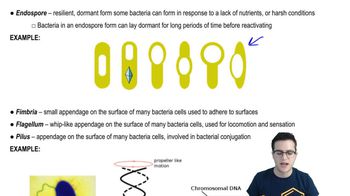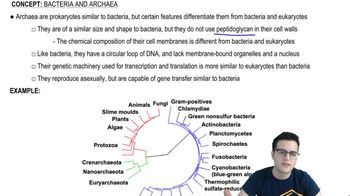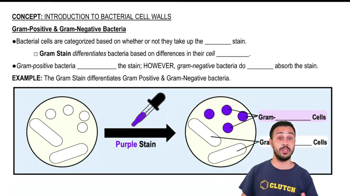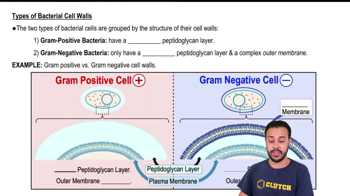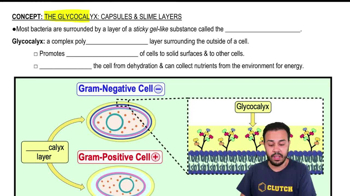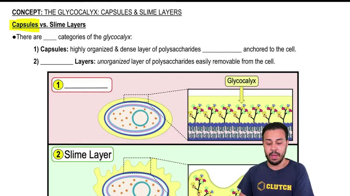Table of contents
- 1. Introduction to Biology2h 42m
- 2. Chemistry3h 40m
- 3. Water1h 26m
- 4. Biomolecules2h 23m
- 5. Cell Components2h 26m
- 6. The Membrane2h 31m
- 7. Energy and Metabolism2h 0m
- 8. Respiration2h 40m
- 9. Photosynthesis2h 49m
- 10. Cell Signaling59m
- 11. Cell Division2h 47m
- 12. Meiosis2h 0m
- 13. Mendelian Genetics4h 44m
- Introduction to Mendel's Experiments7m
- Genotype vs. Phenotype17m
- Punnett Squares13m
- Mendel's Experiments26m
- Mendel's Laws18m
- Monohybrid Crosses19m
- Test Crosses14m
- Dihybrid Crosses20m
- Punnett Square Probability26m
- Incomplete Dominance vs. Codominance20m
- Epistasis7m
- Non-Mendelian Genetics12m
- Pedigrees6m
- Autosomal Inheritance21m
- Sex-Linked Inheritance43m
- X-Inactivation9m
- 14. DNA Synthesis2h 27m
- 15. Gene Expression3h 20m
- 16. Regulation of Expression3h 31m
- Introduction to Regulation of Gene Expression13m
- Prokaryotic Gene Regulation via Operons27m
- The Lac Operon21m
- Glucose's Impact on Lac Operon25m
- The Trp Operon20m
- Review of the Lac Operon & Trp Operon11m
- Introduction to Eukaryotic Gene Regulation9m
- Eukaryotic Chromatin Modifications16m
- Eukaryotic Transcriptional Control22m
- Eukaryotic Post-Transcriptional Regulation28m
- Eukaryotic Post-Translational Regulation13m
- 17. Viruses37m
- 18. Biotechnology2h 58m
- 19. Genomics17m
- 20. Development1h 5m
- 21. Evolution3h 1m
- 22. Evolution of Populations3h 52m
- 23. Speciation1h 37m
- 24. History of Life on Earth2h 6m
- 25. Phylogeny2h 31m
- 26. Prokaryotes4h 59m
- 27. Protists1h 12m
- 28. Plants1h 22m
- 29. Fungi36m
- 30. Overview of Animals34m
- 31. Invertebrates1h 2m
- 32. Vertebrates50m
- 33. Plant Anatomy1h 3m
- 34. Vascular Plant Transport1h 2m
- 35. Soil37m
- 36. Plant Reproduction47m
- 37. Plant Sensation and Response1h 9m
- 38. Animal Form and Function1h 19m
- 39. Digestive System1h 10m
- 40. Circulatory System1h 57m
- 41. Immune System1h 12m
- 42. Osmoregulation and Excretion50m
- 43. Endocrine System1h 4m
- 44. Animal Reproduction1h 2m
- 45. Nervous System1h 55m
- 46. Sensory Systems46m
- 47. Muscle Systems23m
- 48. Ecology3h 11m
- Introduction to Ecology20m
- Biogeography14m
- Earth's Climate Patterns50m
- Introduction to Terrestrial Biomes10m
- Terrestrial Biomes: Near Equator13m
- Terrestrial Biomes: Temperate Regions10m
- Terrestrial Biomes: Northern Regions15m
- Introduction to Aquatic Biomes27m
- Freshwater Aquatic Biomes14m
- Marine Aquatic Biomes13m
- 49. Animal Behavior28m
- 50. Population Ecology3h 41m
- Introduction to Population Ecology28m
- Population Sampling Methods23m
- Life History12m
- Population Demography17m
- Factors Limiting Population Growth14m
- Introduction to Population Growth Models22m
- Linear Population Growth6m
- Exponential Population Growth29m
- Logistic Population Growth32m
- r/K Selection10m
- The Human Population22m
- 51. Community Ecology2h 46m
- Introduction to Community Ecology2m
- Introduction to Community Interactions9m
- Community Interactions: Competition (-/-)38m
- Community Interactions: Exploitation (+/-)23m
- Community Interactions: Mutualism (+/+) & Commensalism (+/0)9m
- Community Structure35m
- Community Dynamics26m
- Geographic Impact on Communities21m
- 52. Ecosystems2h 36m
- 53. Conservation Biology24m
26. Prokaryotes
Prokaryotic Cell Structure
Problem 3`
Textbook Question
Unlike plant cell walls that contain cellulose, bacterial cell walls are composed of ___________.
 Verified step by step guidance
Verified step by step guidance1
Understand the structure of bacterial cell walls: Bacterial cell walls are primarily composed of a substance called peptidoglycan, which is a polymer consisting of sugars and amino acids.
Compare bacterial cell walls to plant cell walls: Plant cell walls are made of cellulose, a polysaccharide, whereas bacterial cell walls contain peptidoglycan, which provides structural support and shape to the bacteria.
Explore the composition of peptidoglycan: Peptidoglycan is made up of repeating units of two types of sugars, N-acetylglucosamine (NAG) and N-acetylmuramic acid (NAM), linked together by short peptide chains.
Consider the function of peptidoglycan: The peptidoglycan layer is crucial for maintaining the integrity and shape of the bacterial cell, protecting it from osmotic pressure and environmental stress.
Recognize the significance of peptidoglycan in bacterial classification: The presence and thickness of peptidoglycan in bacterial cell walls are used to classify bacteria into Gram-positive and Gram-negative groups, which have different structural characteristics.
 Verified video answer for a similar problem:
Verified video answer for a similar problem:This video solution was recommended by our tutors as helpful for the problem above
Video duration:
28sPlay a video:
Was this helpful?
Key Concepts
Here are the essential concepts you must grasp in order to answer the question correctly.
Bacterial Cell Wall Composition
Bacterial cell walls are primarily composed of peptidoglycan, a complex polymer consisting of sugars and amino acids. This structure provides rigidity and protection, distinguishing bacterial cells from plant cells, which have cellulose-based walls. Peptidoglycan's unique composition is crucial for maintaining cell shape and integrity in bacteria.
Recommended video:
Guided course

Introduction to Bacterial Cell Walls
Peptidoglycan Structure
Peptidoglycan is a mesh-like layer that forms the cell wall of most bacteria, composed of repeating units of N-acetylglucosamine and N-acetylmuramic acid linked by short peptide chains. This structure is essential for bacterial survival, providing mechanical strength and preventing osmotic lysis. The cross-linking of peptides gives peptidoglycan its rigidity and resilience.
Recommended video:
Guided course
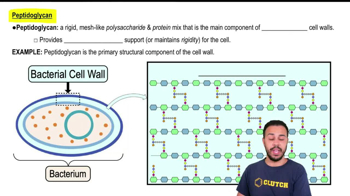
Peptidoglycan
Differences Between Plant and Bacterial Cell Walls
Plant cell walls are primarily made of cellulose, a polysaccharide that provides structural support and protection. In contrast, bacterial cell walls are composed of peptidoglycan, which is unique to bacteria and serves similar protective functions. Understanding these differences is crucial for studying cell wall synthesis and targeting bacterial infections with antibiotics.
Recommended video:
Guided course

Introduction to Bacterial Cell Walls

 3:44m
3:44mWatch next
Master Introduction to Bacterial Cell Walls with a bite sized video explanation from Jason
Start learningRelated Videos
Related Practice



